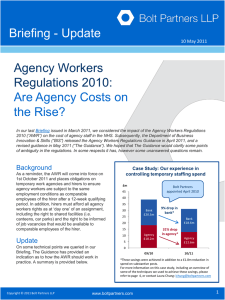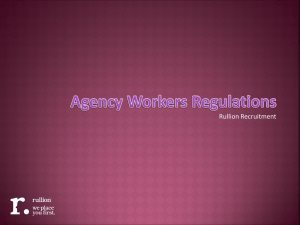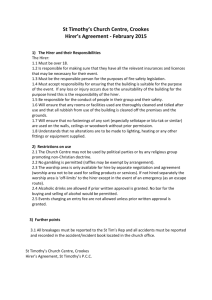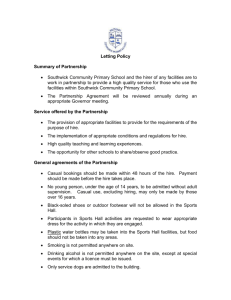Agency Workers Regulations Briefing
advertisement
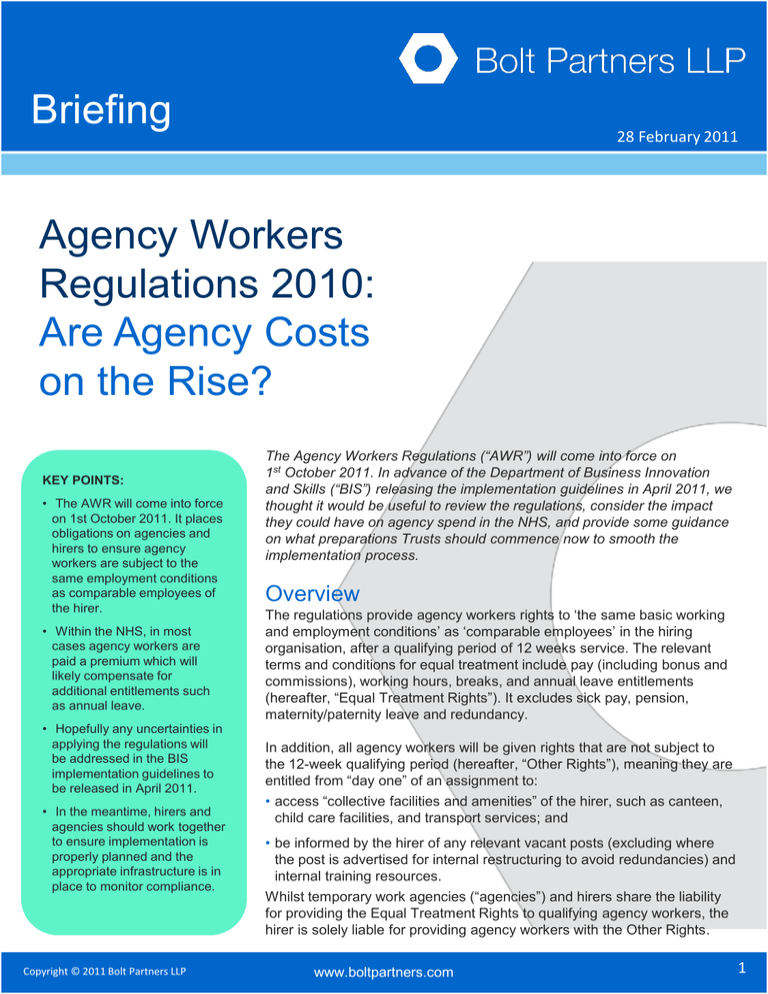
Briefing 28 February 2011 Agency Workers Regulations 2010: Are Agency Costs on the Rise? KEY POINTS: • The AWR will come into force on 1st October 2011. It places obligations on agencies and hirers to ensure agency workers are subject to the same employment conditions as comparable employees of the hirer. • Within the NHS, in most cases agency workers are paid a premium which will likely compensate for additional entitlements such as annual leave. • Hopefully any uncertainties in applying the regulations will be addressed in the BIS implementation guidelines to be released in April 2011. • In the meantime, hirers and agencies should work together to ensure implementation is properly planned and the appropriate infrastructure is in place to monitor compliance. Copyright © 2011 Bolt Partners LLP The Agency Workers Regulations (“AWR”) will come into force on 1st October 2011. In advance of the Department of Business Innovation and Skills (“BIS”) releasing the implementation guidelines in April 2011, we thought it would be useful to review the regulations, consider the impact they could have on agency spend in the NHS, and provide some guidance on what preparations Trusts should commence now to smooth the implementation process. Overview The regulations provide agency workers rights to „the same basic working and employment conditions‟ as „comparable employees‟ in the hiring organisation, after a qualifying period of 12 weeks service. The relevant terms and conditions for equal treatment include pay (including bonus and commissions), working hours, breaks, and annual leave entitlements (hereafter, “Equal Treatment Rights”). It excludes sick pay, pension, maternity/paternity leave and redundancy. In addition, all agency workers will be given rights that are not subject to the 12-week qualifying period (hereafter, “Other Rights”), meaning they are entitled from “day one” of an assignment to: • access “collective facilities and amenities” of the hirer, such as canteen, child care facilities, and transport services; and • be informed by the hirer of any relevant vacant posts (excluding where the post is advertised for internal restructuring to avoid redundancies) and internal training resources. Whilst temporary work agencies (“agencies”) and hirers share the liability for providing the Equal Treatment Rights to qualifying agency workers, the hirer is solely liable for providing agency workers with the Other Rights. www.boltpartners.com 1 After 12 weeks, Agency Workers will have the right to the same basic working conditions (pay, bonus, annual leave, working time) as if they were employed by the Hirer Agency Worker Comparable Employee Temporary work agency Hirer Figure 1: The “three-way relationship” between an Agency Worker, Temporary Work Agency, and Hirer What will compliance involve? Broadly, compliance with the AWR will require the mapping of all agency worker posts to „comparable employee‟ posts in the hiring organisation and making a determination as to whether the existing terms and conditions of the agency worker fall short of the conditions of the comparable employee. In addition, hirers will need to ensure that the Other Rights are extended to all agency workers as a matter of course. These considerations will hopefully be clarified in the BIS implementation guidelines in April 2011. Hirers must also bear in mind that the Equal Treatment Rights only extend to agency workers that qualify by completing 12 weeks continuous service, so the duration of assignments will affect what compliance will involve for different organisations. The 12-week qualifying period is quite broad in application and is discussed in more detail later. In the case of considering the „comparable employee‟ in the NHS, there may be complicating factors such as: Will it increase costs of agency staff in the NHS? • It is unclear what the impact would be of salary banding and pay scales – what is the appropriate „comparable employee‟ pay rate? This is particularly ambiguous for non-clinical staff; The answer to this question depends on: • Since duration of service (and thus annual leave entitlement) in the NHS is tied to the individual from Trust to Trust, it is unclear whether the „comparable employee‟ is assumed to be in the first year of NHS service (with 27 days of annual leave entitlement) or whether the entitlements are calculated as if the agency worker had been recruited by the hirer (taking into account their continuous NHS service and up to 33 days of leave entitlement). Copyright © 2011 Bolt Partners LLP 1. whether there is currently a gap between the pay and working conditions of agency workers and „comparable employees‟ of the hirer; 2. whether agency workers engaged in the hiring organisation are likely to qualify for the rights based upon the duration of assignments; and 3. whether agencies choose to absorb or pass on increased administration and compliance costs For the most part, agency workers in the NHS are already paid at rates premium to that of comparable employees. www.boltpartners.com 2 QUICK FACTS: 1.3 million temporary workers in the UK 10 % engaged in health sector NHS spent c.£1.3 billion on agency staff in 2008/09 The regulations appear to allow a “rolling up” of entitlements into pay rates. For example, where the standard 4-week annual leave entitlement adds 8.3% to the cost of an employee, if the agency rate is already 8.3% higher than the basic pay rate for a „comparable employee‟ then no additional cost would be expected (assuming annual leave was the only relevant term and condition to be applied). An example of how the qualifying period could potentially be satisfied is if a nurse worked one agency shift per month for 12 months for the same Trust, even if through different agencies. In our experience this is not an uncommon pattern of usage of agency workers and therefore it is likely that many agency workers in the NHS will qualify for the Equal Treatment Rights. However, we need to wait until implementation guidelines are produced to see if this is how it will work in practice, and ensure all relevant terms and conditions are taken into account in the comparison analysis. Once the agency worker has met the qualification requirements, he/she must continue to qualify through the same definition of “continuous” service. The 12-week Qualifying Period: Fairly Broad in Scope An agency worker qualifies for Equal Treatment Rights if he/she works „in the same role with the same hirer for 12 continuous calendar weeks‟. The rule is wide in its application: • „12 continuous calendar weeks‟ is satisfied even if there is a break where the agency worker is not working for up to six weeks for any reason, or a break up to 28 weeks for sickness and injury. In that case, the number of continuous weeks of working shall be carried forward and added to number of continuous weeks worked for the hirer after the break For agency workers in posts prior to the AWR coming into force on 1st October 2011, their service prior to this date will not count towards the qualifying period. Compliance Costs and Co-operation with Agencies The Equal Treatment Rights in the AWR place obligations on hirers and agencies which are expected to increase administration costs. Initially, a higher cost is likely due to the need to collate and disseminate information, update policies and procedures, potentially upgrade systems and engage with agencies to agree the approach. Once the process is set up, the administration costs would be significantly lower. • „calendar week‟ includes working the whole or part of any week, so would appear to include working only one shift Copyright © 2011 Bolt Partners LLP www.boltpartners.com 3 There is a risk to hirers that agencies will pass on the increased administration costs through one-off fees or increased rates. However hirers will have some bargaining power to push back - since they must be assured that agency workers are being paid at least as much as a „comparable employee‟, agencies may be forced to reveal their gross margins which the hirers can use to push down prices. Hirers can also minimise internal administration costs by making the most of agencies. Figure 2 sets out the obligations of hirers and agencies in the process: • Hirers can largely ensure compliance with the AWR by providing information and providing appropriate working conditions. Creating standard information packs up-front will ease the ongoing administration burden. • Agencies have the somewhat heavier duty to make the assessment of what the agency worker‟s basic working and employment conditions should be, and ensuring that the worker is paid at the required rate once the qualifying period is satisfied. The process will require significant co-operation between agencies and hirers and it is recommended that the parties should commence discussions now to plan the implementation process. Exclusions In some circumstances the Equal Treatment Rights do not apply: • If the agency worker is permanently employed by the agency and is guaranteed a minimum of 50% of normal pay when not placed on an assignment • Workers under outsourced contracts (for example, the hirer does not have AWR obligations for cleaners and maintenance staff if that service is outsourced) • Whilst the regulations capture umbrella companies, it is not clear whether it is intended to include contactors trading under limited companies The rationale for excluding agency workers that are permanent employees of the agency is that these workers already have a form of income protection and do not need the protections afforded by the AWR. However it is unclear how this will apply to NHS agency workers that use agency work as a supplement to permanent NHS employment. In one possible interpretation of the rules, such agency workers would qualify for annual leave entitlements from both the employer and the hirer (or multiple hirers). It is hoped that the BIS guidelines clarify this. Figure 2: AWR – Equal Treatment Rights – Obligations of Agencies and Hirers Process Obligated Type Start of new agency role Hirer Information Hirer provides information to Agency about basic working and employment conditions in force in the Hirer Within 12-week qualifying period Agency Assessment Agency determines what agency worker’s working and employment conditions should be at the end of the qualifying period Post 12-week qualifying period Agency & Hirer Delivery Agency ensures the agency worker has been treated as a ‘comparable employee’ (to the extent it can, which would mostly be pay-related), Hirer is otherwise liable If role changes Agency Information If an agency worker changes roles, the agency must provide updated information to the agency worker, else the worker will receive Equal Treatment Rights when they otherwise shouldn’t If agency worker claims a breach Agency & Hirer Information An agency worker can make a written request to the agency to provide information about basic working and employment conditions. If no response from the agency within 28 days, the information can be requested from the Hirer Copyright © 2011 Bolt Partners LLP Description www.boltpartners.com 4 Limitations on Claims Conclusion The AWR balances the rights of agency workers and obligations of hirers and agencies by placing relatively tight limitations on claims: • There is a three month time limit for agency workers to lodge complaint to an employment tribunal Whilst we await the release of the BIS implementation guidelines in April 2011 to obtain a more comprehensive idea of how the regulations will work in practice, it is clear that significant information requirements and hirer/agency collaboration will be necessary to ensure organisations are compliant when the rules come into force on 1st October 2011. • The claim must justify compensation amounting to a minimum of two weeks‟ pay (to avoid frivolous claims) We will follow this issue and provide an update when the guidelines are released. However a tribunal can overrule the time and value limitations if, in all the circumstances, it is „just and equitable‟ to do so. References Penalties for Non-Compliance Once a claim is validated, the tribunal will calculate „just and equitable‟ compensation based upon expenses incurred by the agency worker and loss of any benefit (i.e. pay) as consequence of the breach. In addition, up to £5,000 can be awarded to penalise hirers and agencies that have attempted to circumvent the rules in the way the assignment was structured. • The Agency Workers Regulations 2010 • Proposal for a Directive of the European Parliament and the Council on working conditions for temporary workers, Brussels, 2002 • Smith A (2010) „Equal treatment for agency workers: A guide to the Agency Workers Regulations 2010‟, www.cipd.co.uk Emily Montgomery emontgomery@boltpartners.com Laura Chung lchung@boltpartners.com What can hirers do now to prepare? 1. Conduct high level reviews of agency workers‟ current pay and conditions versus comparable employees, and consider the duration of agency workers‟ assignments to estimate the cost implications for the organisation of implementing the AWR 2. For NHS hirers, increase bank resources by incentivising staff to work on the Trust bank rather than do agency shifts elsewhere 3. Revise policies, procedures and systems to ensure that by 1st October 2011, all agency workers have access to collective facilities (e.g. canteen, childcare, transport) and are informed about permanent employment opportunities and internal training resources as a matter of course 4. Prepare information packs to provide to agencies that set out the working and employment conditions of employed staff for roles that agency workers may fill 5. Review information systems and conduct spot checks to see whether existing systems can accurately track an agency worker‟s service in the hirer‟s organisation 6. Set up discussions with agency suppliers to agree an implementation timetable Copyright © 2011 Bolt Partners LLP www.boltpartners.com 5 About Us Bolt Partners LLP is a leading turnaround and performance consulting boutique specialising in healthcare, consumer goods and services, and professional and industrial services. We work with organisations in distressed situations, either as interim executive management (Chief Executive Officer, Chief Financial Officer, Chief Restructuring Officer) or on an advisory basis. Temporary Staffing Controls is an area we specialise in and have proven success in the delivery of significant savings within healthcare organisations and other staff intensive businesses in the United Kingdom. A sample of our credentials is provided below. Case Study 1, 2006 Case Study 2, 2010-11 (ongoing) Background: Background: • The Trust was facing annual temporary staffing spend in nursing of £12m and 300 WTE per annum immediately prior to our engagement • Prior to our involvement, temporary staffing spend was out of control, escalating to c.£41m in FY2010 • • Controls and processes were weak with ownership and accountability lacking With 3 separate bank offices, controls were limited on all aspects of temporary staffing, from authorisation stage through to invoice payments Actions: Appointed January 2006 Actions: Appointed April 2010 • Consolidated the ordering of temporary staff and introduced robust controls resulting in reduction in usage by 100 WTE • Merger of bank offices across 3 sites to centralise internal and external bookings • • Weekly review of spend and usage with firm challenges of expenditure at ward level Introduced weekly reporting and subsequent challenge • • Developed in-house training and toolkit; encouraged planning and sharing of resources across Divisions Increased authorisation levels for all bookings. More stringent controls over long term bookings and additional sessions • Supplier rationalisation and renegotiation • Review of spend within corporate areas • Implemented robust checks and balances on invoices to ensure compliance with new controls • Ban on agency usage within certain staff groups and elimination of usage of non PASA agencies, use only by exception • Renegotiation with preferred suppliers on rates and worked closer with agencies to ensure compliance with new procedures • Greater scrutiny of invoices prior to payment Results: • £5.0m reduction in nursing agency, from £12m to £7m and 100 WTE reduction (delivered recurrent FYE) • Reduced vacancy rate • Decline in reported clinical incidents Results: • £6.0m reduction in Divisional bank and agency, from £35m to £29m (forecast outturn at Month 9) • £2.8m annualised savings from corporate agency achieved within 4 months • Consolidated invoicing on preferred suppliers to one weekly invoice, saving £7 per invoice Contact For more information please contact Laura Chung, lchung@boltpartners.com or Emily Montgomery, emontgomery@boltpartners.com Copyright © 2011 Bolt Partners LLP www.boltpartners.com 6
